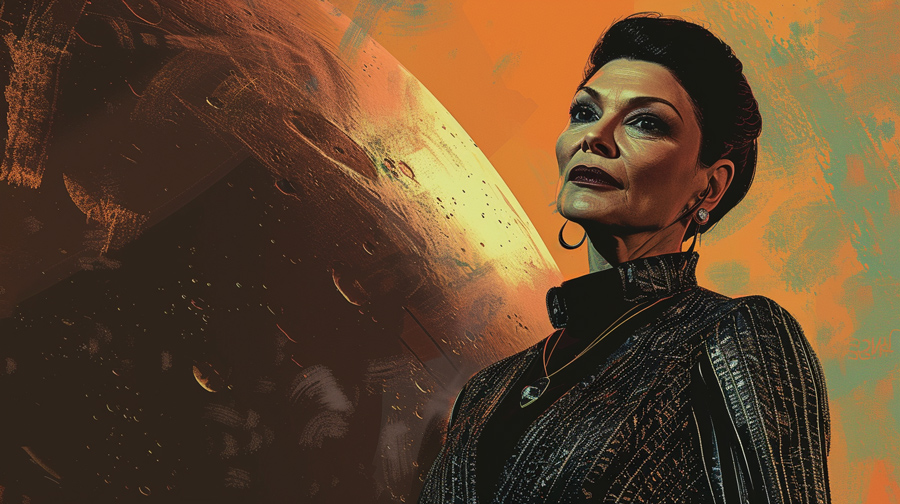James S. A. Corey
James SA Corey, nom de plume for the collaborative writing of Ty Frank and Daniel Abraham. I made this image by blending Ty Frank, Daniel Abraham and James Holden from The Expanse
Introduction
Origins as a Board Game
Transition to a Book Series
Detailed Book-by-Book Summary The book series unfolds over nine main novels, each escalating the stakes and expanding the universe:

Brief Synopsis of the Series Plot
As the series continues, the story changes to include journeys between stars, ancient alien technology, and existential threats, but the narratives about the characters stay unchanged. The books are engaging and make you think about life, and the consequences of what happens to people who attempt to accomplish selfish objectives.
Because it depicts space travel in a realistic way and has complex characters and plots, “The Expanse” is one of the best science fiction shows out there right now.
Leviathan Wakes
Summary of the Plot: introduces Jim Holden, who oversees the ice hauler Canterbury, and Detective Miller, who serves on Ceres Station and is a tired cop. After a mysterious stealth ship destroys the Canterbury, Holden and his crew discover a plot involving the Protomolecule, an alien material that is capable of havoc on a scale never seen before. At the same time, Miller is searching for Julie Mao, the daughter of a powerful billionaire who has ties to the Protomolecule. As they discover a plan that threatens all of mankind, their paths cross.
Key Characters and Their Arcs: Holden’s ideals place him in direct conflict with powerful forces, while Miller’s journey turns him from a detective who has lost hope into a man who has a purpose. Putting together the Rocinante crew is very important because it sets the stage for their subsequent adventures.
Major Themes: Power and greed, the moral difficulties of being a leader, and the effects of finding strange technology are all looked at.
Summary of the Plot: As the Protomolecule starts to spread in “Caliban’s War,” tensions rise between Earth, Mars, and the Belt. Holden and his crew become involved in the conflict and make new friends, such as the Martian marine Bobbie Draper and the smart UN politician Chrisjen Avasarala. They work together to find a way to prevent the Protomolecule from being turned into a weapon, which starts a frantic battle to stop a full-scale war.
Key Characters and Their Arcs: Bobbie Draper’s dedication is put to the test, and she develops into a key protector of humanity. Avasarala demonstrates how gifted she is at politics by becoming a key figure in the fight against the misuse of the Protomolecule. Holden’s leadership continues to improve even though things are bad.
Major Themes: The horrors of war, political intrigue, and the ethical dilemmas of advanced technology.
 Abaddon’s Gate
Abaddon’s Gate
Summary of the Plot: “Abaddon’s Gate” sees the Protomolecule creating a massive ring structure outside the orbitt of Uranus, leading to an international mission to investigate. Holden and the Rocinante crew, along with representatives from Earth, Mars, and the Belt, venture through the ring into an enormous structure with over a thousand gates leading to other systems.
Key Characters and Their Arcs: Holden faces visions from the Protomolecule, questioning his sanity and leadership. The introduction of Clarissa Mao, seeking revenge, adds tension and complexity to the crew’s dynamics.
Major Themes: The unknown dangers of new frontiers, revenge and redemption, and the search for understanding alien technology.
 Cibola Burn
Cibola Burn
“Cibola Burn” focuses on the colonization of new worlds accessible through the ring gates. On the planet Ilus, tensions between corporate interests and Belter settlers erupt into violence. The Rocinante crew is sent to mediate the conflict, discovering ancient alien technology that complicates matters further.
Key Characters and Their Arcs: Holden’s mediation skills are tested as he strives to maintain peace. Naomi’s connection to the Belters is explored more deeply. New characters like scientist Elvi Okoye bring fresh perspectives.
Major Themes: The clash between corporate exploitation and settler rights, the perils of alien technology, and the challenges of pioneering new worlds.
Summary of the Plot: “Nemesis Games” sees the Rocinante crew temporarily splitting up to deal with personal challenges. A catastrophic attack on Earth by the rogue Belter faction led by Marco Inaros threatens the solar system’s stability. The crew must reunite to confront this emerging threat and restore order.
Key Characters and Their Arcs: Naomi’s past with Marco Inaros is revealed, adding depth to her character. The other crew members face their own trials, deepening their individual arcs.
Major Themes: Family and loyalty, radicalism and its consequences, and the struggle for survival and power.
 Babylon’s Ashes
Babylon’s Ashes
Summary of the Plot: In “Babylon’s Ashes,” the solar system is engulfed in chaos as Marco Inaros continues his campaign against Earth and Mars. The Rocinante crew takes a central role in the fight to stop him, forming alliances with various factions. The conflict reaches a climax as they strive to restore order and prevent further destruction.
Key Characters and Their Arcs: The crew’s loyalty to each other and their broader alliances are tested. Themes of unity and resilience against tyranny are emphasized.
Major Themes: The costs of war, the power of unity, and resistance against oppression.
 Persepolis Rising
Persepolis Rising
Summary of the Plot: Set decades after previous events, “Persepolis Rising” introduces a new threat from Laconia, led by Duarte, who has used Protomolecule technology to build an empire. The Rocinante crew, now older and more experienced, faces a vastly changed political landscape and must confront this new power.
Key Characters and Their Arcs: The aging crew grapples with their evolving roles in the new order. The rise of Laconia challenges their ideals and strategies.
Major Themes: The rise and fall of empires, ethical use of advanced technology, and enduring fight for freedom.
Tiamat’s Wrath
Summary of the Plot: The Laconian Empire tightens its grip on the solar system, but resistance forces, including the Rocinante crew, continue to fight back. As they uncover more about the Protomolecule and its creators, they face both human and alien threats. The stakes are higher than ever as they strive to undermine Duarte’s regime.
Key Characters and Their Arcs: The crew’s determination and ingenuity are pushed to their limits. Personal sacrifices and the pursuit of knowledge drive the plot forward.
Major Themes: Resistance against oppression, quest for knowledge, and cost of freedom.
Summary of the Plot: The series concludes with an epic showdown between the Laconian Empire and the forces of resistance. As secrets about the Protomolecule and ancient alien civilizations are revealed, humanity’s fate hangs in the balance. The Rocinante crew plays a pivotal role in the final battle for the solar system’s future.
Key Characters and Their Arcs: Each character faces their ultimate challenges and makes final decisions that shape the outcome. Themes of legacy and the enduring human spirit are central.
Major Themes: Survival, legacy, and humanity’s place in the universe.
 The Expanse Series Collection
The Expanse Series Collection
9 Books Set By James S A Corey (Leviathan Wakes, Caliban’s War, Abaddons Gate, Cibola Burn, Nemesis Games, Babylons Ashes, Persepolis Rising & More)
Novellas and Short Stories
Character Analysis


Key Supporting Characters


Adaptation into a TV Series
Fan Campaign to Save the Show
- Social Media Campaign: Fans took to Twitter, Facebook, and other social media platforms using the hashtag #SaveTheExpanse. The campaign aimed to raise awareness and demonstrate the show’s strong following.
- Petition: An online petition on Change.org garnered over 100,000 signatures, calling for a streaming service or another network to pick up the show.
- Banner Flyover: Through a GoFundMe campaign, fans raised money to hire an airplane to fly a banner over Amazon Studios in Los Angeles. The banner read “Save The Expanse” and featured the hashtag, attracting significant media attention.
- Model Rocinante Launch: Fans built and launched a model of the Rocinante, the show’s iconic spaceship, into space. This symbolic gesture further highlighted the show’s passionate fanbase and garnered additional media coverage.
Jeff Bezos and Amazon
Model Rocinante Launch: A Symbolic Gesture to Save "The Expanse"
- Concept and Planning
- The idea to launch a model of the Rocinante, the iconic spaceship from “The Expanse,” originated from a group of dedicated fans who wanted to do something extraordinary to demonstrate their support for the series. The Rocinante, often affectionately referred to as “Roci,” is central to the show’s narrative and represents the adventurous spirit and resilience of its characters.
- Fundraising Efforts
- To turn this ambitious idea into reality, fans organized a crowdfunding campaign on platforms like GoFundMe. The campaign quickly gained traction, raising funds from fans around the world who were eager to contribute to the cause. The fundraising goal covered the costs of building the model, obtaining the necessary equipment for the launch, and ensuring proper documentation of the event.
- Building the Model
- The model Rocinante was meticulously crafted to resemble the spaceship featured in “The Expanse.” Fans paid close attention to detail, ensuring that the model was as accurate as possible. This involved careful design and construction, utilizing materials that could withstand the conditions of a high-altitude balloon flight.
- Launch Preparation
- The team collaborated with high-altitude balloon experts to plan the launch. The balloon would carry the model Rocinante to the edge of space, simulating a space launch. This required precise calculations to ensure the balloon would reach the desired altitude and safely return to the ground.
- The Launch Event
- The launch took place in early May 2018, just days after Syfy announced the cancellation of “The Expanse.” The event was carefully documented with video and photography to capture the moment. The balloon ascended to the edge of space, reaching an altitude where the curvature of the Earth and the blackness of space were visible. This dramatic imagery symbolized the show’s themes of space exploration and human ingenuity.
- Media Coverage and Social Media Impact
- The launch of the model Rocinante generated significant media coverage, with numerous news outlets reporting on the fans’ creative efforts. Social media buzzed with excitement as fans shared photos and videos of the launch. The hashtag #SaveTheExpanse continued to trend, amplifying the visibility of the campaign.
- Symbolic Significance
- The launch was more than just a publicity stunt; it embodied the spirit of “The Expanse.” The show’s narrative often focuses on the struggle for survival and the drive to explore the unknown. By launching the Rocinante into space, fans echoed these themes, demonstrating their unwavering support and determination to see the show continue.
- Outcome and Legacy
- The model Rocinante launch was one of the many factors that contributed to the successful campaign to save “The Expanse.” The combined efforts of fans, media attention, and the support of influential figures like Jeff Bezos ultimately led to Amazon Prime Video picking up the show for a fourth season.
- The initiative left a lasting legacy within the fan community and is remembered as a powerful example of fan activism. It highlighted the impact that a dedicated and passionate fanbase can have on the fate of a beloved series.
Impact of the Acquisition
Themes and Motifs
- Political Intrigue and Power Dynamics
- The series delves deep into the complex political landscape of a future where humanity is divided into factions: Earth, Mars, and the Belt. The power struggles and alliances between these groups are central to the story, highlighting the ever-present theme of political maneuvering and its impact on society.
- Exploration and Colonization of Space
- The drive to explore and colonize new worlds is a recurring motif. “The Expanse” portrays the challenges and ethical dilemmas associated with humanity’s expansion into the cosmos, from the harsh realities of living in space to the moral questions surrounding the use of alien technology.
- Human Nature and Its Consequences
- At its core, “The Expanse” is a study of human nature. It explores how individuals and societies react under pressure, the capacity for both good and evil, and the unintended consequences of human actions. The series frequently poses questions about what it means to be human in an increasingly technological world.
- The Role of Technology and Science
- Technology and science are integral to the narrative, from the advanced spacecraft and weapons to the enigmatic Protomolecule. The series examines the double-edged sword of technological advancement, showcasing both its potential to elevate humanity and the dangers it poses when misused.
- Survival and Adaptation
- The harsh environments of space and the constant threat of conflict require characters to adapt and survive against formidable odds. This theme is prevalent in the series, emphasizing resilience, resourcefulness, and the human spirit’s tenacity.
World-Building Overview
Planets, Ships, and Stations
- Earth: The cradle of humanity, Earth remains a powerful and influential entity in the solar system. It is portrayed as overpopulated and resource-strained, with a bureaucratic government striving to maintain its dominance.
- Mars: A former colony of Earth, Mars is depicted as a militaristic and technologically advanced society focused on terraforming the planet. The Martians are driven by a strong sense of purpose and independence.
- The Belt: The asteroid belt is home to the Belters, who live and work in the harshest conditions of space. They have developed their own unique culture and language, reflecting their struggle for survival and autonomy.
- Spaceships: The series features a wide array of spacecraft, from the massive battleships of Earth and Mars to the versatile and nimble Rocinante. Each ship is meticulously designed, emphasizing the practicalities and dangers of space travel.
- Space Stations: Key locations like Tycho Station and Ceres Station serve as hubs of activity and conflict, showcasing the political and economic complexities of life in space.
The Belters, Martians, and Earthers:
- Belters: The Belters have developed a culture of resourcefulness and resilience, shaped by their harsh environment. They often view themselves as marginalized and oppressed, leading to tensions with Earth and Mars. Their unique language, Belter Creole, and customs reflect their identity and solidarity.
- Martians: Martians are characterized by their dedication to the dream of terraforming Mars and their military discipline. Their society values scientific advancement and self-sufficiency, often leading to a rivalry with Earth.
- Earthers: Earth, with its long history and bureaucratic government, represents tradition and authority. The population’s diverse background and Earth-centric perspective often clash with the aspirations of the Martians and Belters.
The Protomolecule and Its Implications
- Origins and Discovery: The Protomolecule is first discovered by the crew of the Rocinante, setting off a series of events that drive much of the plot. It is an enigmatic substance with the potential to reshape life and matter at a fundamental level.
- Impact on Humanity: The Protomolecule’s abilities to create and destroy pose existential questions and threats. Its presence sparks political and military conflicts as different factions vie for control and understanding of its power.
- Alien Gate Network: The Protomolecule leads to the creation of a ring gate network, providing access to thousands of new star systems. This discovery opens up new frontiers for exploration and colonization but also brings new dangers and challenges
Technological and Scientific Realism
- Space Travel: The series depicts the challenges of living and traveling in space, from zero-gravity environments to the effects of high-G maneuvers on the human body. The use of realistic physics enhances the credibility and immersion of the story.
- Technological Advances: Advanced technology, such as Epstein drives and magnetic boots, is integrated into the narrative in a plausible manner. The depiction of space habitats, weaponry, and medical technology reflects thoughtful consideration of future possibilities.
Reception and Impact
- Inspiration for New Works: The success of “The Expanse” has inspired other authors and creators to explore similarly detailed and expansive science fiction worlds. Its blend of hard science fiction and character-driven narrative has set a benchmark for future works.
- Renewed Interest in Space Opera: The series has contributed to a resurgence of interest in space opera as a genre, demonstrating its potential for complex storytelling and rich world-building.
- Discussions and Analysis: The themes and motifs of “The Expanse” have sparked extensive discussions and analyses within the science fiction community. Its exploration of political and social issues in a futuristic setting has provided a framework for examining contemporary concerns through the lens of speculative fiction.
- Fan Community: The series has cultivated a passionate and dedicated fanbase, known for their engagement with the books and TV show. Fan theories, discussions, and creative works have proliferated online, contributing to the series’ enduring popularity.
- Merchandise and Spin-Offs: The success of “The Expanse” has led to the creation of various merchandise, including board games, graphic novels, and other spin-off media. These products have expanded the universe and provided fans with additional ways to engage with the story.
- Academic and Literary Recognition: The series has been the subject of academic studies and literary analysis, examining its themes, narrative structure, and cultural significance. “The Expanse” is frequently cited in discussions of modern science fiction’s evolution and its role in reflecting and shaping societal issues.
- Syfy Acquisition: The TV series adaptation began with Syfy acquiring the rights and premiering the first season in 2015. The show received critical acclaim for its faithfulness to the source material, high production values, and strong performances.
- Amazon Prime: After Syfy canceled the show after three seasons, Amazon Prime picked it up, allowing the series to continue and reach an even broader audience. The show’s move to Amazon Prime brought higher production budgets and greater creative freedom, enhancing its ability to capture the essence of the books.
- Critical and Audience Reception: The TV series has been praised for its complex storytelling, visual effects, and character development. It has maintained a strong fanbase and received positive reviews from critics, cementing its status as a significant work in televised science fiction.
- Hugo Awards: The series won the Hugo Award for Best Series in 2020, a testament to its overall excellence and impact on the science fiction genre.
- Locus Awards: Several books in the series have been nominated for the Locus Award for Best Science Fiction Novel, with “Leviathan Wakes” securing a nomination in 2012.
- Goodreads Choice Awards: The books have consistently been popular in the Goodreads Choice Awards, reflecting strong reader support and engagement.
Who is James S. A. Corey?
Daniel Abraham
Ty Franck
- James – This comes from Ty Franck’s middle name.
- S.A. – These are the initials of Daniel Abraham’s daughter.
- Corey – This is a tribute to Abraham’s friend and fellow author, Corey Doctorow.










 Auberon (2019) – Set between “Tiamat’s Wrath” and “Leviathan Falls,” explores the political landscape of a newly colonized world.
Auberon (2019) – Set between “Tiamat’s Wrath” and “Leviathan Falls,” explores the political landscape of a newly colonized world.